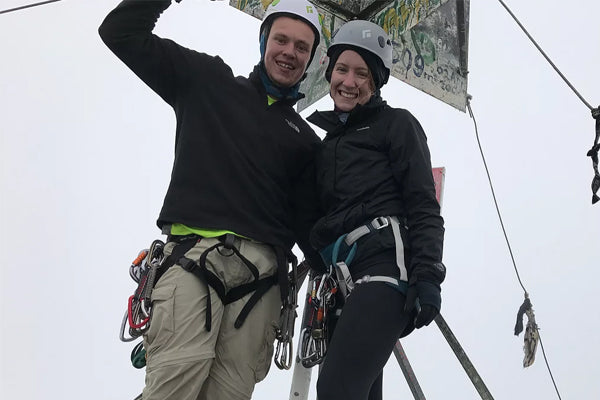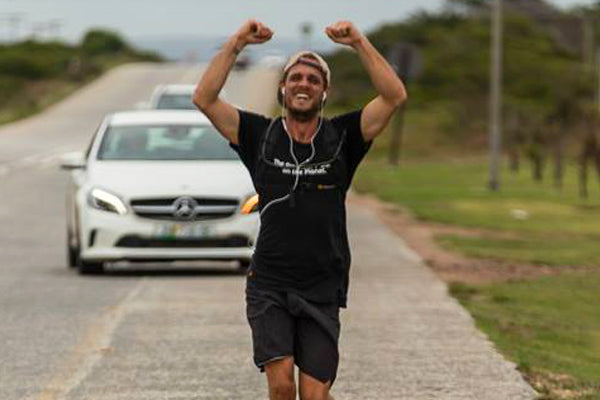The Greenest Tee - Women size chart

Hawaii isn’t all beaches and coconut mojitos, it’s also the home of one of the world’s toughest multi-day run events. The Mauna to Mauna is a self supported (yep!) 7 day, 6 stage, 250km race across the big island of Hawaii. If that’s not tough enough, competitors had to cross 11 of the 13 climatic regions of the world from rugged lava to sandy beaches and open grassland...There was also a lot of rain.
Kusaga Athletic Phillip Dernee was one of nutters to tackle this event, winning his age group and 10th overall...we asked him what drew him to this monster of an event?
Kusaga: Can you tell us about the race?
Phill: Mauna to Mauna is one of those week-long, self supported, international field, stunning location style races. 250km (155 mile) split over 6 stages and 7 days with about 6,800m (22,000ft) of elevation ascent and descent. Starting on the eastern side of the big island and finishing on the western side. 2017 was the inaugural running of the event with 72 competitors from over 20 countries taking part.
Kusaga: What was the motivation to take on the Mauna to Mauna race?
Phill: To follow in the footsteps of the ‘Kukini’. Kukini in the local language means ‘very fast runners’, in the 1,500 years of island life before European integration, the local royalty (Aili’i) would employ those that demonstrated athletic ability as messengers and heralds who they named the ‘Kukini’. Legends of a famous Kukini named Makoa still permeate the local culture and stories of his amazing ability to run all over the island delivering messages in service of the local king are still told.
Also my first ever ultra-marathon was a stage race event in 2013 and I haven’t done one since, I wanted to see whether the first one was a fluke or not.
Also, it was held in Hawaii, enough said!
Kusaga: How do you approach a 6 day 250km self supported race?
Phill: I approached the race by spending 3 nights at a rowdy backpackers on the northern shore of Oahu.
To be honest if you asked each of the 72 competitors, you would get 72 different answers. The key to the approach is in the name, ‘self-supported’, approach the race as if your heading out alone to do it by yourself. I love it, it breaks everything down into ‘do I really need this, or is it useless’. The obvious ‘needs’ are water, food, running clothes, warm/dry clothes for camp and something to sleep in and on.
Kusaga: What was one of the highlights and what was one of the lowlights during the race?
Phill: A highlight was and still is the other competitors, volunteers, race organisers (lame, cliché answer I know!). The diversity, kindness, intrigue and joy found amongst all those involved in the event was intense. I hope to have shared similar traits back to them in kind.
Lowlights I’m not sure; with the passing of time any experience I perceived as a low point during the week now, with the rosy-eyed advantage of hindsight, appears as a character building moment. Perhaps the initial change in course before starting the event was a lowlight; initially the course was designed to start on the eastern side of the island and with each stage continue across the island in an unbroken line before finishing on the western side. Due to land ownership and permission issues raised only days before the event (USA! USA!) the organisers were forced to amend the course. The race started on the eastern coast and finished on the western coast as originally designed, however our course across the island was broken and we had a less linear journey. Basically I’m just bummed that I can not now accurately say I’ve run across the big island of Hawaii, instead that I’ve run 250km of zig-zagging around the big island of Hawaii. Again local legends told of the Kukini completing runs across the big island and I wanted to be part of the first people since them to complete such a journey.
Kusaga: Any advice to someone thinking about taking on any ultra marathon races?
Phill: Do it, do it in your own way, do it in your own time, do it in your own style.
My advice, which I don’t expect too many to take on board, would be; do it not for the finishing line, or the glory, or the bragging afterwards (like I do now with this report haha). Do it for the journey and the experience, do it for the things it teaches you and the difficulties it brings. There’s nothing (that I’ve come across yet anyway) that is more worthwhile than taking something just beyond your comfort zone. Nor anything more rewarding than reaping the benefits when you return back to the comfort zone with perspective freshly renewed.
Kusaga: What kit did you ta along with you?
Phill: I used a real big, heavy backpack (more of a hiking backpack) and more changes of clothes and warm gear than was necessarily ‘needed’ which worked out ace! I ended up having one of the heaviest backpacks but it was comfortable, supportive and didn’t rub the wrong places (unless I packed it poorly, which I sometimes did), what’s more I was snug as a bug at camp and didn’t want for food during the event (my happiness is usually related to how much food I have near me at any given moment, so I was keen to make sure I had enough food).
I, of course, besmirched the Kusaga shirts I took with two great big ironed on stickers, one the Australian flag and one the M2M logo on each arm sleeve (as was required by race rules). I’m happy to say the shirts did the job admirably. On the long day (stage 4, 78km) the organisers stagger the start, at 8am the majority of the field starts and then at 11am the 15 quickest runners start. I was amongst the 15 quickest and so had 3 extra hours waiting around camp for the start of the day, you’d think I’d spend that time on ensuring I was ready, but no. 5km into the long stage it dawns on me that I haven’t taped the ol’ nipples (a habit I’m in for marathon plus distances to prevent any annoying chafe and nipple agony). I push it from thought, if chafing starts – which it usually does around 35km in, I’ll stop, tape myself up and be on with it. 13 hours and 70km later my ‘chesticle’s’ were fresh as daisies with no irritation in sight (or sense).
On the long day we experienced hot sun, running up and through clouds, cold temps at night, humid and muggy conditions. Likewise over the course of the week Hawaii presented us with 3 days of non-stop rain on one side of the island and 3 days of hot, humid, sun-drenched heat on the other side of the island. I like to run in anything and everything, as long as the distance or weather isn’t too extreme. After the blessing of ‘no-chafe’ on a day that bought both extreme weather and long distances, I’ll be wearing a Kusaga shirt on any future days that push me outside of my comfort zone.
Kusaga: Anything else you would like to add?
Phill: Thank you to the awesome people that sent an email of support to me during the race (basically mum and dad, and a couple other nutters), it was much appreciated!
Find out more about Phill Dernee's adventures: Phill's blog
Read more from our blog: The UTA 100 - Australia's Premier Ultra event







Lily Clements
Author